

Continuous Performance Management: Innovation Reigns. One of the most fundamental and difficult parts of management (and HR) is how we do performance management.
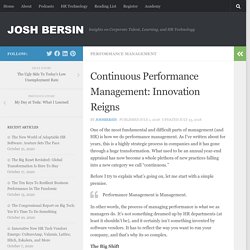
As I’ve written about for years, this is a highly strategic process in companies and it has gone through a huge transformation. What used to be an annual year-end appraisal has now become a whole plethora of new practices falling into a new category we call “continuous.” Before I try to explain what’s going on, let me start with a simple premise. Us human capital bersin lt vendor landscape pm primer 07 2019. Performance Reviews Are Dead. Here's What You Should Do Instead. Anyone who has had the privilege to lead has also had the responsibility of the dreaded annual performance review.
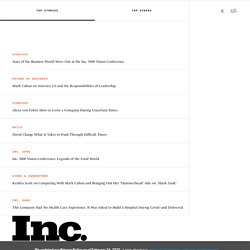
We've all been through them, but I've yet to meet anyone who actually looks forward to a performance review, anymore than they would a root canal. Not only is it stressful for both parties involved but it's also horribly ineffective. According to the Society for Human Resource Management, and as reported in Slate, "95% of employees are dissatisfied with their company's appraisal process. What's more, 90 percent don't believe the process provides accurate information.
" Worse yet, an Adobe study found that performance reviews have no effect on how they do their job. "We've Always Done It That Way," Just Isn't Reason Enough So, why do we keep doing them? And so we've muddled our way through them as best we could, all the while knowing something just wasn't quite right about the awkward and seemingly ineffective process. The Real-time 360 How It Works. The Future of Performance Reviews. Executive Summary Hated by bosses and subordinates alike, traditional performance appraisals have been abandoned by more than a third of U.S. companies.
The annual review’s biggest limitation, the authors argue, is its emphasis on holding employees accountable for what they did last year, at the expense of improving performance now and in the future. That’s why many organizations are moving to more-frequent, development-focused conversations between managers and employees. The authors explain how performance management has evolved over the decades and why current thinking has shifted: (1) Today’s tight labor market creates pressure to keep employees happy and groom them for advancement. (2) The rapidly changing business environment requires agility, which argues for regular check-ins with employees. (3) Prioritizing improvement over accountability promotes teamwork.
A version of this article appeared in the October 2016 issue (pp.58–67) of Harvard Business Review. Performance Management Best Practices — Impraise Blog - Employee performance management, reviews and 360 feedback. In order to succeed in the increasingly agile and fluid contemporary work environment in which we find ourselves, it is advisable to include the former 5 concepts into your performance management structures.
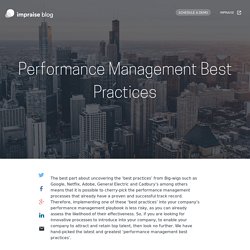
Meaningful work: It is important that employees are engaged with their work. They need to be managed sure, but they also must have sufficient autonomy so that they can utilise their own skills and talents in the denouement of their projects. Hands-on Management: Hands on management, does not mean micro management; but rather refers to the need to use your own competencies as a manager to provide coaching and mentorship to employees when a need exists.
Additionally managers should manage in an open an upfront way. This enables managers to get the very best out of their employees; as both parties are aware of precisely what is expected of them. Positive work environment: This is a straightforward one; managers should encourage a workplace that is motivating, encouraging and positive. The Future of Performance Reviews. Managing Performance Evaluations During a Pandemic. During a time of crisis, it can be difficult to operate business as usual.
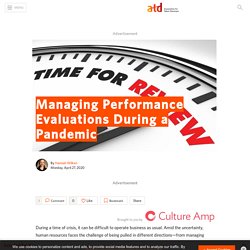
Amid the uncertainty, human resources faces the challenge of being pulled in different directions—from managing communications and crisis response planning to maintaining some level of business continuity. As the Society for Human Resource Management (SHRM) suggests, it’s critical for organizations to aim to manage operations with minimal loss and disruption to the normal business flow. Uniting your employees around the common goal of doing their best to run “business as usual” can help inspire and enable them to refocus during a crisis.
Maintaining the organization’s operations also offers some of the safety, normalcy, and comfort that people would usually find in the routine of daily life at work. Over the last few days, we have heard of organizations abandoning their current or upcoming performance cycle, giving everyone the same rating, or just continuing with evaluations as planned. Managing Employee Performance and Rewards in a COVID-19 World. The world is changing because of COVID-19.
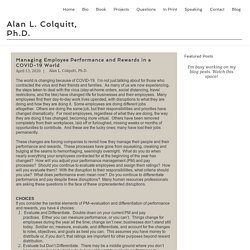
I’m not just talking about for those who contracted the virus and their friends and families. As many of us are now experiencing, the steps taken to deal with the virus (stay-at-home orders, social distancing, travel restrictions, and the like) have changed life for businesses and their employees. Redefine Performance Management to Drive Impact. For performance management to be effective, it must be useful.
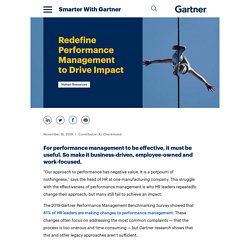
So make it business-driven, employee-owned and work-focused. “Our approach to performance has negative value. It is a potpourri of nothingness,” says the head of HR at one manufacturing company. This struggle with the effectiveness of performance management is why HR leaders repeatedly change their approach, but many still fail to achieve an impact. Transforming performance management? Start with the end in mind - Capital H Blog. Part 2 of a 3-part series Posted by Joan Goodwin, Diane Morris, Greg Scott, and Josh Davis on October 16, 2019.
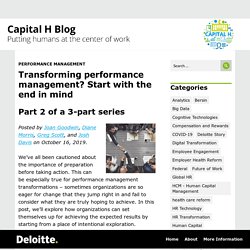
We’ve all been cautioned about the importance of preparation before taking action. This can be especially true for performance management transformations – sometimes organizations are so eager for change that they jump right in and fail to consider what they are truly hoping to achieve. In this post, we’ll explore how organizations can set themselves up for achieving the expected results by starting from a place of intentional exploration. The first part of this series describes common pitfalls of performance management transformations. Based on our experience, organizations looking to transform performance management should make an upfront investment in considering the big picture: Before moving forward, we take severalbig steps back and answer five critical questions that help us get started the right foot.
Question 2: What outcomes do we want to drive? Transforming performance management? Part 3: Invest for success - Capital H Blog. Part 3 of a 3-part series Posted by Joan Goodwin, Diane Morris, Greg Scott, and Josh Davis on Febuary 06, 2019.

The pressure is on. Performance Management, Disrupted: Enabling Performance in the Flow of Work - Capital H Blog. Posted by Kathi Enderes on September 24, 2018.

Performance reviews are dead! Long live performance reviews! This sums up the last few years’ heated discussion around reviews, ratings, and performance management (PM). I was excited by the opportunity to lead a broad industry study regarding performance management as my first priority with Bersin. We Wasted Ten Years Talking About Performance Ratings. The Seven Things We've Learned. I can’t tell you how many meetings I’ve had talking with companies about changing their performance management process.

Going back to 2015 articles were written by people like Marcus Buckingham and Ashley Goodall (both personal friends), and many others about the need to change year-end ratings, implement regular feedback practices, and reduce the power of the manager in the process. Many people cite the research from Personnel Psychology in 1998 and Journal of Applied Psychology in 2000 that raters are biased and unreliable, and that almost 50% of the variation in performance ratings is based on the manager, not the employee. In other words, the year-end review is imperfect, and we need better data to make good people decisions. Well here we are entering 2019, and the debate rages on. I’ve been studying this topic for almost 20 years now, and while this is a problem that will never fully be solved, let me try to summarize where I believe we are.
Good enough. Getting real on managing employee performance. In this episode of the McKinsey Podcast, McKinsey Publishing’s Lucia Rahilly speaks with McKinsey partner Bryan Hancock and senior partner Bill Schaninger about the role managers can and should play in coaching their employees on a regular basis, designing fair compensation systems, and knowing how to handle good—and challenging—conversations. Podcast transcript Lucia Rahilly: Welcome to the McKinsey Podcast.
I’m Lucia Rahilly, sitting in for the podcast’s regular host, Simon London. Agile performance management. The evidence is clear: a small number of priority practices make the difference between an effective and fair performance-management approach and one that falls short. Organizations that link employee goals to business priorities, invest in managers’ capabilities, and differentiate rewards for the extremes of performance are 84 percent more likely to have performance-management approaches that their employees perceive and recognize as being fair.
Furthermore, these practices are mutually reinforcing: implementing one practice well can have a positive effect on the performance of others, which leads to positive impact on employee and organizational performance, which, in turn, drives organizations to outperform peers. But how do these priority practices work in the context of agile organizations, which feature networks of empowered teams and rely on a dynamic people model? Harnessing the power of performance management. These days, performance management is a source of dissatisfaction at many organizations. Large shares of respondents to a recent McKinsey Global Survey on the topic say their organizations’ current systems and practices have no effect—or even a negative one—on company performance. Moreover, they do not see positive returns on investment for the time spent on performance management.
Yet the results also show that when executed well, performance management has a positive impact on employees’ performance and the organization’s performance overall. Our analysis indicates that the key to reaping positive business outcomes from performance management is to establish a system that employees and managers perceive as fair. To ensure that perception, managers should master three critical practices: linking individuals’ goals with business priorities, coaching effectively, and differentiating compensation across levels of performance. Ahead of the curve: The future of performance management.
The worst-kept secret in companies has long been the fact that the yearly ritual of evaluating (and sometimes rating and ranking) the performance of employees epitomizes the absurdities of corporate life. Future Trends in Performance Management. By Brett Christie, WorldatWork. 5 Performance Management Trends from Gartner, Mercer, Gallup, BetterWorks, and HBR. In the last decade, performance management has seen a tectonic shift from annual to continuous systems.